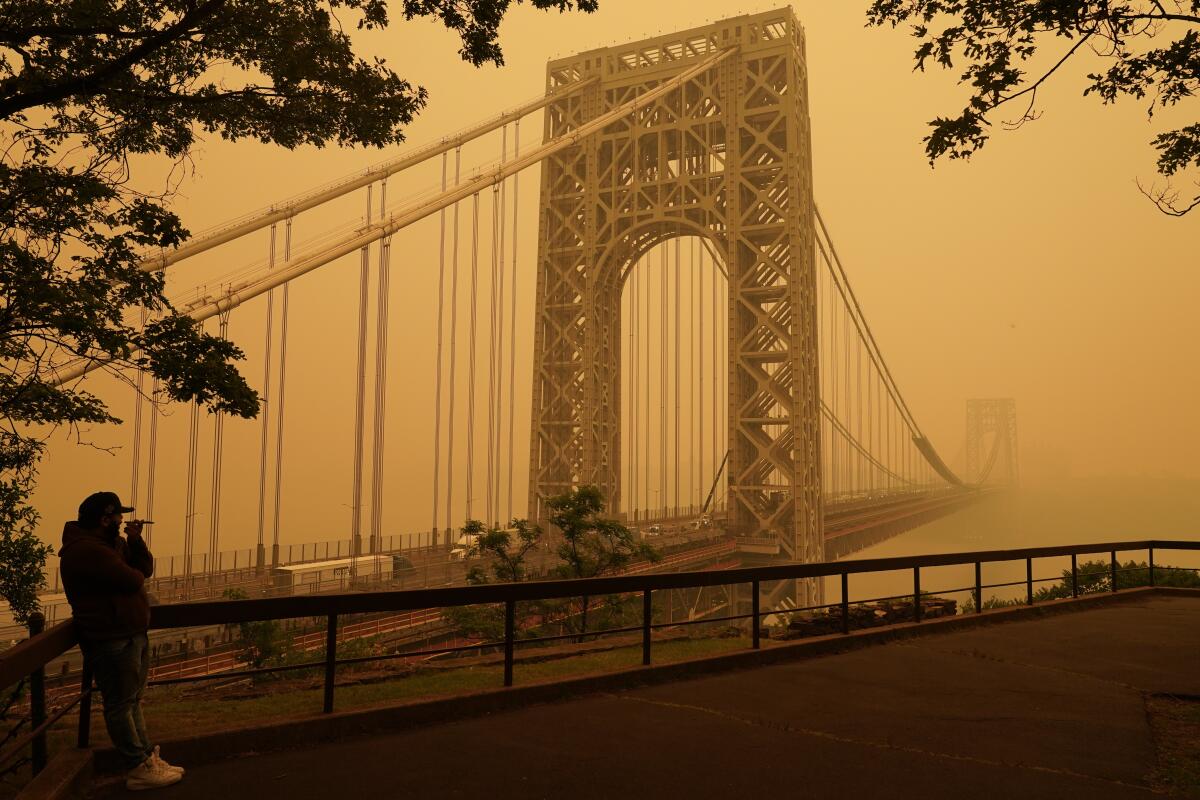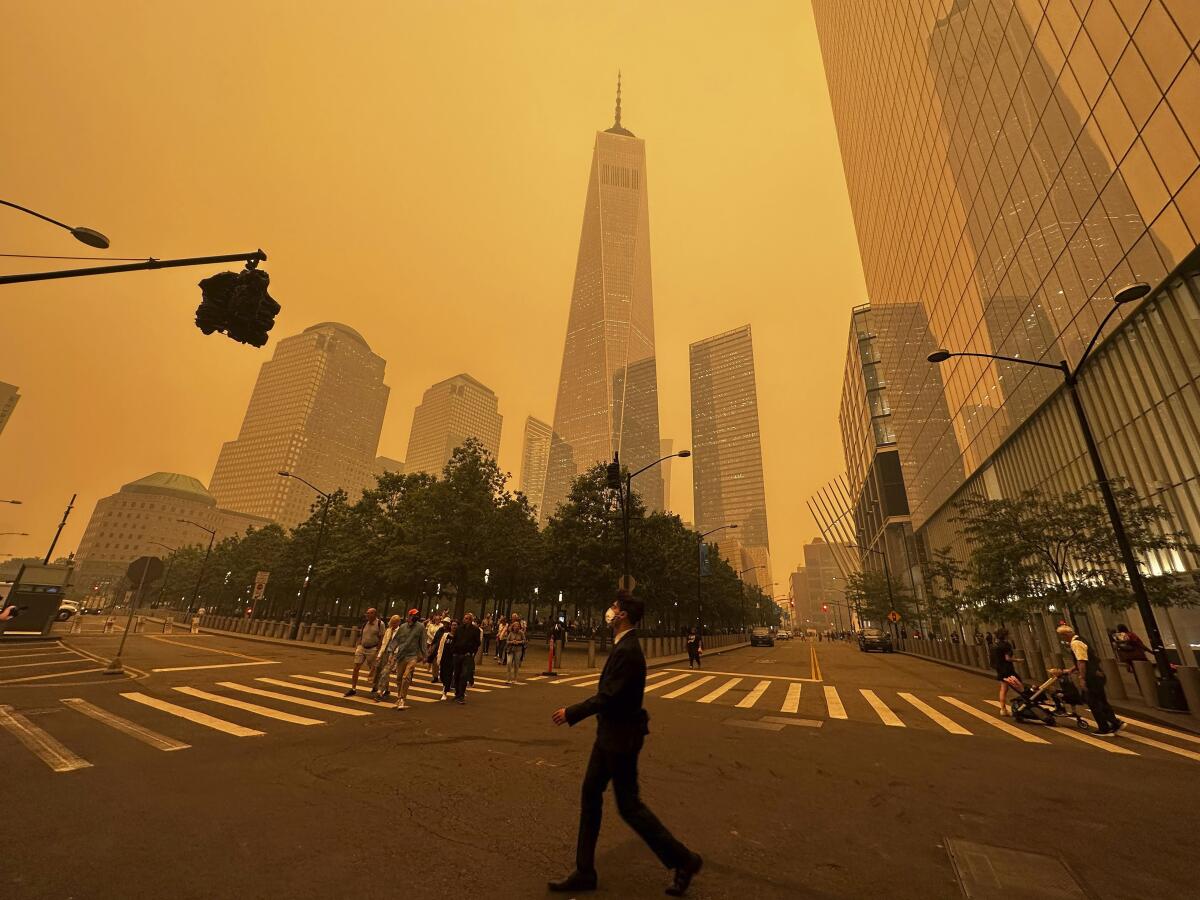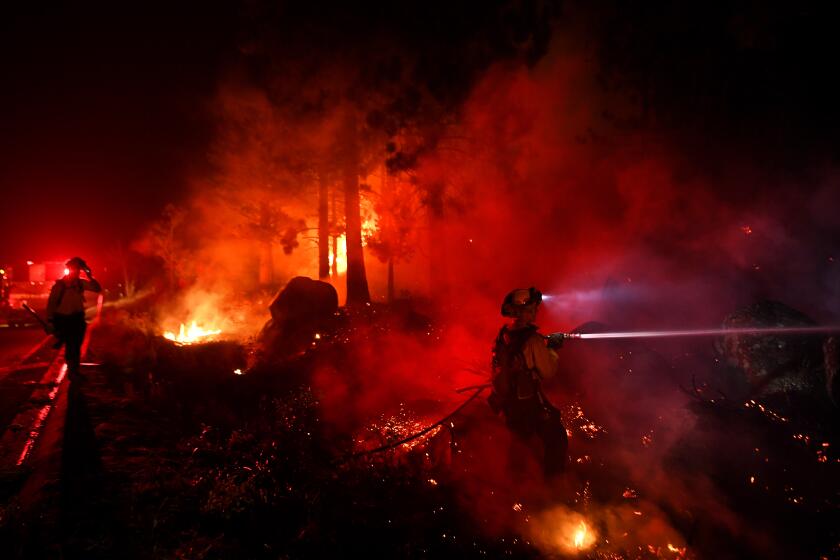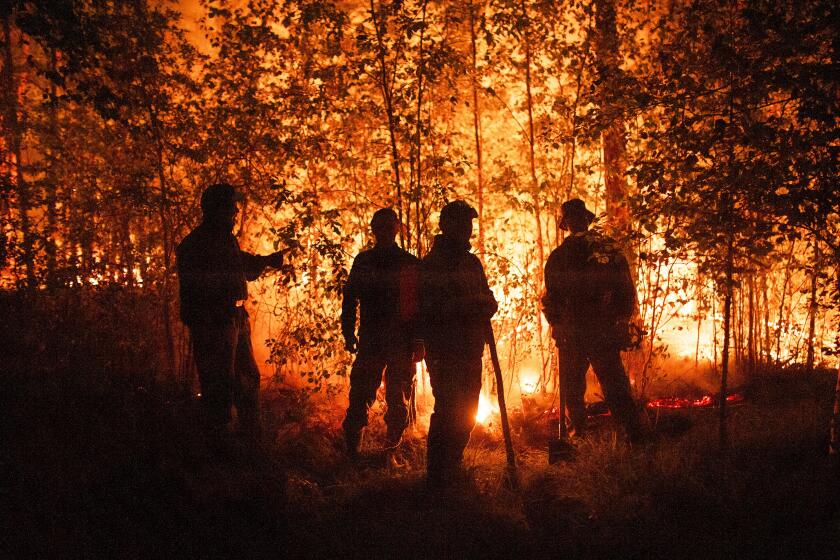Canadian wildfire smoke spreads hazardous haze through northeastern U.S.

NEW YORK — Smoke from Canadian wildfires poured into the U.S. East Coast and Midwest on Wednesday, covering the capitals of both nations in an unhealthy haze, holding up flights at major airports and prompting people to fish out pandemic-era face masks.
While Canadian officials asked other countries for help fighting more than 400 blazes nationwide that already have displaced 20,000 people, hazardous levels of pollution extended into central New York. Massive tongues of unhealthy air extended as far as Virginia and Indiana, affecting millions of people.
“I can taste the air,” Dr. Ken Strumpf said in a Facebook post from Syracuse, N.Y., which was enveloped in an amber pall. The smoke, he later said by phone, made him a bit dizzy.
In Baltimore, where officials warned residents to stay indoors when possible, Debbie Funk sported a blue surgical mask as she and husband, Jack Hughes, took their daily walk around Ft. McHenry, the national monument overlooking the Patapsco River. The air hung thick over the water, obscuring the horizon as distant ships pushed slowly through the haze.
“I walked outside this morning and it was like a waft of smoke,” said Funk, who said the couple had considered skipping the walk but wanted some exercise. The two planned to stay inside later Wednesday.
Canadian officials say this is shaping up to be the nation’s worst wildfire season ever. It started early on drier-than-usual ground and accelerated very quickly, exhausting firefighting resources across the country, fire and environmental officials said.
A United Nations report on the growth of extreme wildfires worldwide suggests California can do more to increase fire resiliency.
Smoke from the blazes in various parts of the country has been drifting into the U.S. since last month but intensified with a recent spate of fires in Quebec, where more than 100 were burning and considered out of control Tuesday.
“The smoke was insane yesterday. I had to close my window because the fresh air just smelled like campfire,” said Zachary Kamel, 36, of Montreal.
Quebec Premier François Legault has said the province has the capacity to fight about 40 fires at the moment — and the usual reinforcements that could be called in from other provinces have already been strained by fires in Nova Scotia and elsewhere.
Canadian Interagency Forest Fire Center spokesperson Jennifer Kamau said more than 950 firefighters and other personnel have already arrived from the U.S., Australia, New Zealand and South Africa, and more will be arriving soon.
The largest town in Northern Quebec — Chibougamau, population about 7,500 — was evacuated Tuesday, after another Quebec community was left to burn Monday, drawing the ire of local residents. Legault said firefighters had no choice because the flames around the hamlet of Clova were too intense to send in water bombers. No homes had burned as of Tuesday.
Eastern Quebec got some rain Wednesday, but Montreal-based Environment Canada meteorologist Simon Legault said no rain is expected for days in the remote areas of central Quebec where the wildfires are more intense.
U.S. National Weather Service meteorologist Zach Taylor said the current weather pattern in the central and eastern U.S. is essentially funneling in the smoke. Some rain should help clear the air somewhat in the Northeast and Mid-Atlantic this weekend or early next week, though more thorough relief will come from containing or extinguishing the fires, he noted.

Across the border, New York Gov. Kathy Hochul warned the public to “prepare for this over the long haul,” New York City Mayor Eric Adams told residents to limit outdoor activities as much as possible.
The Federal Aviation Administration paused some flights bound for LaGuardia Airport and slowed planes to Newark Liberty because the smoke was limiting visibility. The smoke also was contributing to delayed arrivals at Dulles International Airport outside Washington.
Schools in multiple states canceled sports and other outdoor activities, shifting recess and lunch time inside. Live horse racing was canceled Wednesday and Thursday at Delaware Park in Wilmington. Organizers of Global Running Day, a virtual 5K and celebration of running, posted a warning on their website advising participants to monitor the air quality in their cities and change their running plans accordingly.
A warming planet and land-use changes mean more wildfires will scorch large parts of the globe in coming decades, according to a new U.N. report.
Some political demonstrations were moved indoors or postponed, and striking Hollywood writers were pulled off picket lines in the New York metropolitan area.
Sitting in a Brooklyn park with a black mask on her face, nanny Meagan Bobb said she was surprised by how bad the air was.
“The little girl was coughing, and I was having problems breathing when I was walking around, so we’re looking to go inside somewhere soon,” Bobb said.
The smoke was a particular worry for people such as Vicki Burnett, 67, who has asthma and has had serious bouts with bronchitis.
After taking her dogs out Wednesday morning in Farmington Hills, Mich., Burnett said, “I came in and started coughing and hopped back into bed.”
Still, she stressed that she’s concerned for Canadians, not just herself.
“It’s unfortunate, and I’m having some problems for it, but there should be help for them,” she said.
Peltz reported from New York and Gillies from Toronto. Associated Press journalists Randall Chase in Dover, Del.; Michael Hill in Albany, N.Y.; Brooke Schultz in Mechanicsburg, Pa.; Mark Scolforo in Harrisburg, Pa.; Lea Skene in Baltimore; Carolyn Thompson in Buffalo, N.Y.; Ron Todt in Philadelphia; Corey Williams in West Bloomfield, Mich.; and Jake Offenhartz, Karen Matthews and Julie Walker in New York. contributed to this report.
More to Read
Sign up for Essential California
The most important California stories and recommendations in your inbox every morning.
You may occasionally receive promotional content from the Los Angeles Times.












